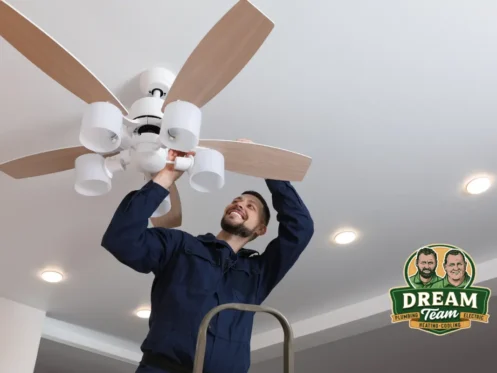How To Use Fans To Lower Utility Bills and Maximize Efficiency
You’ve probably heard that using fans to lower utility bills by running them alongside your AC can lead to big savings. After all, who doesn’t love the idea of saving some extra cash to spend on a warm weather activity that you’ve been waiting for? However, let’s clear up the misconception once and for all.
While the notion of slashing your energy costs with a simple flick of a switch sounds appealing, the reality is often far more nuanced. Many homeowners eagerly adopt this strategy, hoping to see a noticeable drop in their monthly utility bills. Yet, the truth behind the effectiveness of ceiling fans in reducing energy consumption isn’t quite as straightforward as it seems.
Understanding the dynamics of how ceiling fans operate in conjunction with air conditioners is crucial in dispelling this commonly held belief. Contrary to popular perception, ceiling fans do not inherently lower the ambient temperature of a room. Instead, their primary function lies in creating a breeze that helps evaporate moisture from the skin, providing a cooling sensation. In essence, they augment the cooling effect produced by your air conditioner by enhancing air circulation.
So, does this mean that running ceiling fans is an exercise in futility when it comes to curbing energy expenditure? Not necessarily. While it’s true that ceiling fans don’t directly impact the temperature of a room, they can contribute to energy savings when used judiciously.
Understanding the Role of Ceiling Fans
As previously mentioned, ceiling fans do not actively cool the air within a room. In reality, the primary function of a ceiling fan is not to lower the ambient temperature but rather to create a cooling sensation on your skin through air movement. While the gentle breeze generated by a fan can indeed provide relief on hot days, it does not directly alter the temperature of the surrounding air.
In contrast, your air conditioner operates on a different principle, working to regulate indoor temperatures by circulating cooled air and removing heat from the environment. Unlike ceiling fans, which rely on airflow to induce a cooling effect, air conditioners actively extract heat from indoor spaces, thereby reducing the overall temperature.
It’s essential to recognize the distinct roles that ceiling fans and air conditioners play in maintaining comfort within your home. While ceiling fans excel at enhancing personal comfort through airflow, they do not possess the capability to lower room temperatures in the same manner as air conditioners. Instead, their effectiveness lies in facilitating sweat evaporation and providing a sense of coolness to occupants.
This doesn’t necessarily mean that ceiling fans are a frivolous energy expenditure. When used correctly and in conjunction with other cooling methods, such as air conditioning, ceiling fans can contribute to overall energy efficiency and comfort. By strategically positioning ceiling fans in occupied areas and adjusting their speed and direction as needed, homeowners can maximize their utility while minimizing energy consumption. By understanding the distinct functions of ceiling fans and air conditioners and leveraging them effectively, homeowners can create a comfortable indoor environment while minimizing energy costs.
Optimizing Ceiling Fan Usage
One common mistake homeowners make is leaving ceiling fans running in empty rooms, assuming they’re helping their ACs work more efficiently. However, if no one is there to benefit from the airflow, it’s just wasted energy.
Indeed, allowing ceiling fans to run needlessly in empty rooms amounts to an unnecessary expenditure of energy, which can ultimately result in inflated utility bills. To mitigate this wastage and optimize energy usage, it’s imperative to cultivate the habit of switching off ceiling fans when rooms are vacant.
By adopting this straightforward yet impactful measure, homeowners can curtail unnecessary energy consumption and maintain control over their utility costs. This proactive approach not only promotes responsible energy usage but also aligns with sustainability goals by minimizing environmental impact.
In essence, the key to harnessing the potential benefits of ceiling fans lies in their strategic use of only turning fans on when there are occupants in the room. By turning off fans in unoccupied rooms, homeowners can maximize energy efficiency and contribute to a more sustainable and cost-effective living environment.
The key is painfully simple, turn off ceiling fans when rooms are unoccupied and turn them back on when they are occupied. This simple habit can prevent unnecessary energy consumption and keep utility bills in check.
Rethinking Thermostat Settings
Another important consideration is adjusting your thermostat settings when using ceiling fans. Because the fan’s airflow creates a cooling sensation on your skin, you can raise the thermostat by a few degrees without sacrificing comfort. For example, if you typically set your thermostat to 72 degrees, try raising it to 77 degrees while running the fan. You’ll still feel comfortable but use less energy. Read our article to learn more about thermostats and smart home automation.
Maximizing Energy Savings
To maximize energy savings with your ceiling fan and AC combo, follow these two steps:
-
Raise the thermostat by about five degrees, or more if you’re still comfortable. The higher temperature reduces AC usage, resulting in lower energy consumption.
-
Only run ceiling fans when you’re in the room to enjoy the airflow. Remember to turn them off when leaving to avoid wasting electricity.
- Optimize your HVAC system
Additional Benefits of Ceiling Fan Usage
Beyond energy savings, ceiling fans offer additional benefits like air circulation and temperature regulation. Some models even come with features like reversible blades for year-round use and energy-efficient lighting options.
If you’re looking to enhance your home’s energy efficiency further, consider consulting with our professionals about HVAC, plumbing and/or electrical options tailored to your needs. At Dream Team, we’re committed to helping you achieve optimal comfort while reducing energy costs.



